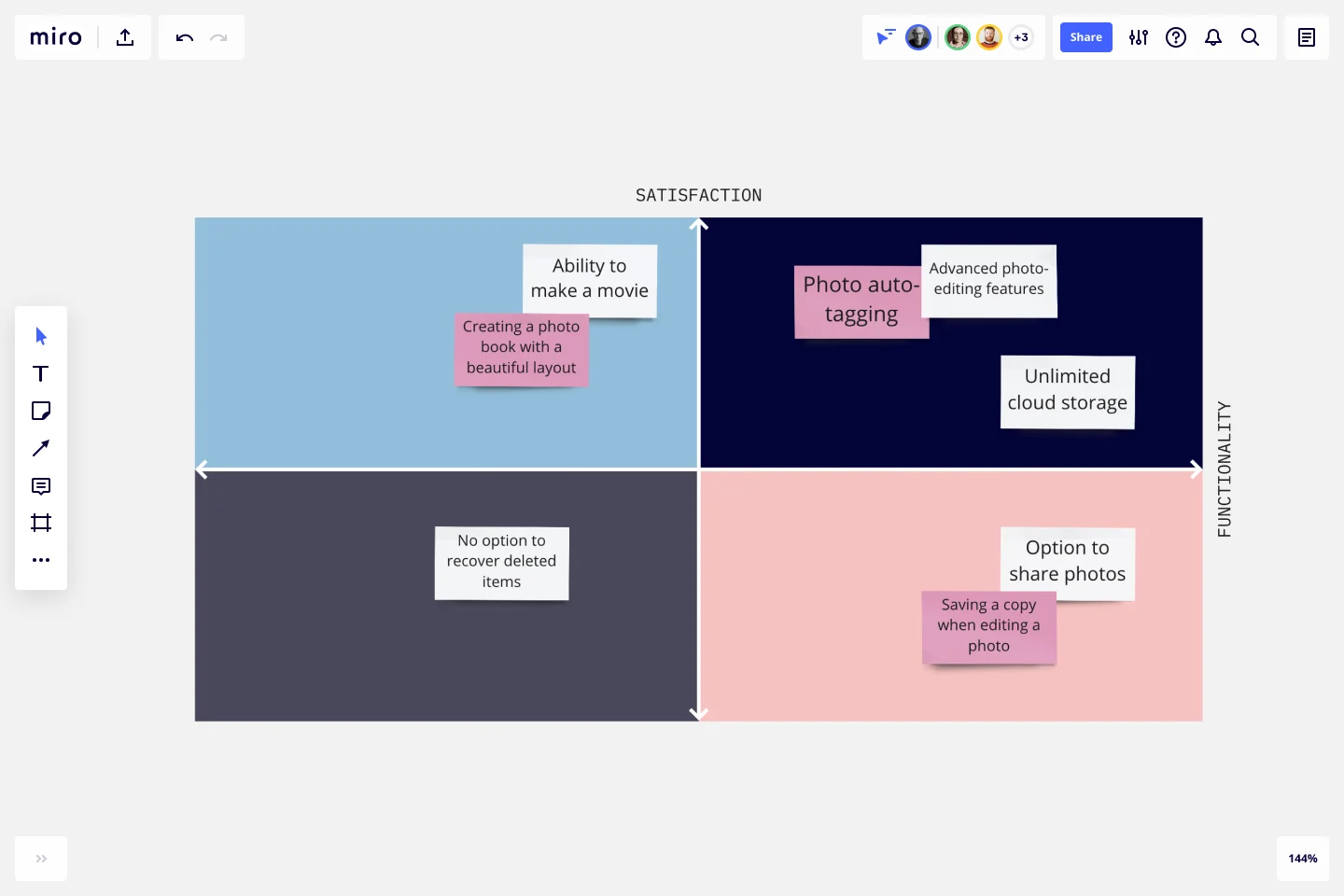Kano Model Template
Kano Analysis is a powerful tool where you can map which product attributes which are perceived to be important to customers. Ideal for product development and customer satisfaction.
About the Kano model template
What is the Kano model?
The Kano model is a method for prioritizing features on a product roadmap. Prioritization is assigned based on the likelihood that a given feature will satisfy your customers. Product teams can use the Kano model to weigh a high-satisfaction feature against the costs of implementation, making it easier to decide whether they should add this feature to the roadmap. Many product managers prioritize features by grouping them into categories based on whether they are likely to disappoint, satisfy, or delight customers.
How does the Kano model work?
The Kano model uses two axes: satisfaction and functionality. The axes create a quadrant with four values: attractive, performance, indifferent, and must-be. Teams can use this model to understand, prioritize, and integrate the main categories of customer requirements into the products they develop. When teams understand which requirements are most valuable to customers, they can plan and use resources wisely.
What are the four categories in the Kano model?
The Kano model classifies features into four categories based on how customers might react to them.
Performance: These features directly impact whether the product is good at performing its intended function. Put another way: the more of this feature you receive, the greater your satisfaction will be. Gas mileage is the most common example. When you’re buying a car, you treat gas mileage as a Performance attribute.
Must-be: Customers expect these features. If your product doesn’t have one, then your customers will consider your project bad or incomplete. For example, you expect your car to have brakes. If it doesn’t have brakes, you’re not buying it.
Attractive: Although these features aren’t strictly necessary, they cause a positive reaction. A leather interior doesn’t make a car work any better, but it’s nice to have and increases the value of the car.
Indifferent: The presence or absence of this feature does not impact you in any way. Organizations typically avoid working on features that fall into this category because they are a waste of resources.
Create your own
Now that you know how to create your own Kano model, get started with this free template. It’s easy to create and share it with your teammates.
Get started with this template right now.
Website Wireframing Template
Works best for:
Wireframes, User Experience
Wireframing is a method for designing a website at the structural level. A wireframe is a stylized layout of a web page showcasing the interface elements on each page. Use this Wireframe Template to iterate on web pages quickly and cheaply. You can share the wireframe with clients or teammates and collaborate with stakeholders. Wireframes allow teams to get stakeholder buy-in without investing too much time or resources. They help ensure that your website’s structure and flow will meet user needs and expectations.
Agenda Template
Works best for:
Project Management, Meetings, Workshops
Even when you’ve hosted meetings for years, hosting them online is different. Keeping them structured, purposeful, and on-task is key. That all starts with having a detailed agenda, and this template makes it so easy for you to create one.
Burndown Chart Template
Works best for:
Project Management, Agile Workflows, Mapping
Whoa whoa whoa, pace yourself! That means knowing how much work is left—and, based on the delivery date, how much time you’ll have for each task. Perfect for project managers, Burndown Charts create a clear visualization of a team’s remaining work to help get it done on time and on budget. These charts have other big benefits, too. They encourage transparency and help individual team members be aware of their work pace so they can adjust or maintain it.
Year Timeline Template
Works best for:
Timeline, Planning
The Year Timeline template provides a comprehensive view of annual events and milestones. Perfect for planning yearly goals, tracking progress, and scheduling important dates, this template helps you stay organized and focused throughout the year.
HEART Framework Template
Works best for:
Desk Research, Project Management, User Experience
Happiness, Engagement, Adoption, Retention, and Task Success. Those are the pillars of user experience — which is why they serve as the key metrics in the HEART framework. Developed by the research team at Google, this framework gives larger companies an accurate way to measure user experience at scale, which you can then reference throughout the product development lifecycle. While the HEART framework uses five metrics, you might not need all five for every project — choose the ones that will be most useful for your company and project.
Retrospective - Christmas Edition
Works best for:
Agile Methodology, Retrospectives, Meetings
The Retrospective Christmas Edition template offers a festive and themed approach to retrospectives, perfect for the holiday season. It provides elements for reflecting on the year's achievements, sharing gratitude, and setting intentions for the upcoming year. This template enables teams to celebrate successes, foster camaraderie, and align on goals amidst the holiday spirit. By promoting a joyful and reflective atmosphere, the Retrospective - Christmas Edition empowers teams to strengthen relationships, recharge spirits, and start the new year with renewed energy and focus effectively.
